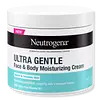Uriage Cica Daily Concentrated Repair Cream Versus Neutrogena Ultra Gentle Face & Body Moisturizing Cream
What's inside
What's inside
 Key Ingredients
Key Ingredients

 Benefits
Benefits

 Concerns
Concerns

No concerns
 Ingredients Side-by-side
Ingredients Side-by-side

Water
Skin ConditioningSqualane
EmollientDicaprylyl Ether
EmollientCaprylic/Capric Triglyceride
MaskingButyrospermum Parkii Butter
Skin ConditioningPolyglyceryl-3 Methylglucose Distearate
EmulsifyingGlycerin
HumectantGlyceryl Stearate
Emollient1,2-Hexanediol
Skin ConditioningPentaerythrityl Distearate
EmulsifyingGlyceryl Behenate
EmollientHydroxyacetophenone
AntioxidantInulin
Skin ConditioningPotassium Cetyl Phosphate
EmulsifyingPanthenol
Skin ConditioningSodium Polyacrylate
AbsorbentAcrylates/C10-30 Alkyl Acrylate Crosspolymer
Emulsion StabilisingTocopheryl Acetate
AntioxidantXanthan Gum
EmulsifyingSafflower Oil/Palm Oil Aminopropanediol Esters
Skin ConditioningSodium Hyaluronate
HumectantSodium Hydroxide
BufferingCentella Asiatica Leaf Extract
Skin ConditioningCitric Acid
BufferingTocopherol
AntioxidantWater, Squalane, Dicaprylyl Ether, Caprylic/Capric Triglyceride, Butyrospermum Parkii Butter, Polyglyceryl-3 Methylglucose Distearate, Glycerin, Glyceryl Stearate, 1,2-Hexanediol, Pentaerythrityl Distearate, Glyceryl Behenate, Hydroxyacetophenone, Inulin, Potassium Cetyl Phosphate, Panthenol, Sodium Polyacrylate, Acrylates/C10-30 Alkyl Acrylate Crosspolymer, Tocopheryl Acetate, Xanthan Gum, Safflower Oil/Palm Oil Aminopropanediol Esters, Sodium Hyaluronate, Sodium Hydroxide, Centella Asiatica Leaf Extract, Citric Acid, Tocopherol
Water
Skin ConditioningGlycerin
HumectantCetyl Alcohol
EmollientCocoglycerides
EmollientHelianthus Annuus Seed Oil
EmollientPanthenol
Skin ConditioningCentella Asiatica Extract
CleansingButylene Glycol
HumectantTocopherol
AntioxidantAscorbyl Palmitate
AntioxidantCarbomer
Emulsion StabilisingZea Mays Starch
AbsorbentPotassium Cetyl Phosphate
EmulsifyingHydrogenated Palm Glycerides
EmollientHydrogenated Castor Oil
EmollientLecithin
EmollientDisodium EDTA
Ethylhexylglycerin
Skin ConditioningP-Anisic Acid
MaskingPhenoxyethanol
PreservativeSodium Hydroxide
BufferingWater, Glycerin, Cetyl Alcohol, Cocoglycerides, Helianthus Annuus Seed Oil, Panthenol, Centella Asiatica Extract, Butylene Glycol, Tocopherol, Ascorbyl Palmitate, Carbomer, Zea Mays Starch, Potassium Cetyl Phosphate, Hydrogenated Palm Glycerides, Hydrogenated Castor Oil, Lecithin, Disodium EDTA, Ethylhexylglycerin, P-Anisic Acid, Phenoxyethanol, Sodium Hydroxide
 Reviews
Reviews

Ingredients Explained
These ingredients are found in both products.
Ingredients higher up in an ingredient list are typically present in a larger amount.
Glycerin is already naturally found in your skin. It helps moisturize and protect your skin.
A study from 2016 found glycerin to be more effective as a humectant than AHAs and hyaluronic acid.
As a humectant, it helps the skin stay hydrated by pulling moisture to your skin. The low molecular weight of glycerin allows it to pull moisture into the deeper layers of your skin.
Hydrated skin improves your skin barrier; Your skin barrier helps protect against irritants and bacteria.
Glycerin has also been found to have antimicrobial and antiviral properties. Due to these properties, glycerin is often used in wound and burn treatments.
In cosmetics, glycerin is usually derived from plants such as soybean or palm. However, it can also be sourced from animals, such as tallow or animal fat.
This ingredient is organic, colorless, odorless, and non-toxic.
Glycerin is the name for this ingredient in American English. British English uses Glycerol/Glycerine.
Learn more about GlycerinPanthenol is a common ingredient that helps hydrate and soothe the skin. It is found naturally in our skin and hair.
There are two forms of panthenol: D and L.
D-panthenol is also known as dexpanthenol. Most cosmetics use dexpanthenol or a mixture of D and L-panthenol.
Panthenol is famous due to its ability to go deeper into the skin's layers. Using this ingredient has numerous pros (and no cons):
Like hyaluronic acid, panthenol is a humectant. Humectants are able to bind and hold large amounts of water to keep skin hydrated.
This ingredient works well for wound healing. It works by increasing tissue in the wound and helps close open wounds.
Once oxidized, panthenol converts to pantothenic acid. Panthothenic acid is found in all living cells.
This ingredient is also referred to as pro-vitamin B5.
Learn more about PanthenolPotassium Cetyl Phosphate is the potassium salt of a mixture. This mixture consists of the esters from phosphoricacid and cetyl alcohol.
Potassium Cetyl Phosphate is an emulsifier and cleansing agent. Emulsifiers help stabilize a product. It does this by preventing certain ingredients from separating.
As a cleansing agent, Potassium Cetyl Phosphate helps gather oils, dirts, and pollutants from your skin. This makes it easier to rinse them away with water.
Learn more about Potassium Cetyl PhosphateSodium Hydroxide is also known as lye or caustic soda. It is used to adjust the pH of products; many ingredients require a specific pH to be effective.
In small amounts, sodium hydroxide is considered safe to use. However, large amounts may cause chemical burns due to its high alkaline.
Your skin has a natural pH and acid mantle. This acid mantle helps prevent harmful bacteria from breaking through. The acid mantle also helps keep your skin hydrated.
"Alkaline" refers to a high pH level. A low pH level would be considered acidic.
Learn more about Sodium HydroxideTocopherol (also known as Vitamin E) is a common antioxidant used to help protect the skin from free-radicals and strengthen the skin barrier. It's also fat soluble - this means our skin is great at absorbing it.
Vitamin E also helps keep your natural skin lipids healthy. Your lipid skin barrier naturally consists of lipids, ceramides, and fatty acids. Vitamin E offers extra protection for your skin’s lipid barrier, keeping your skin healthy and nourished.
Another benefit is a bit of UV protection. Vitamin E helps reduce the damage caused by UVB rays. (It should not replace your sunscreen). Combining it with Vitamin C can decrease sunburned cells and hyperpigmentation after UV exposure.
You might have noticed Vitamin E + C often paired together. This is because it is great at stabilizing Vitamin C. Using the two together helps increase the effectiveness of both ingredients.
There are often claims that Vitamin E can reduce/prevent scarring, but these claims haven't been confirmed by scientific research.
Learn more about TocopherolWater. It's the most common cosmetic ingredient of all. You'll usually see it at the top of ingredient lists, meaning that it makes up the largest part of the product.
So why is it so popular? Water most often acts as a solvent - this means that it helps dissolve other ingredients into the formulation.
You'll also recognize water as that liquid we all need to stay alive. If you see this, drink a glass of water. Stay hydrated!
Learn more about Water